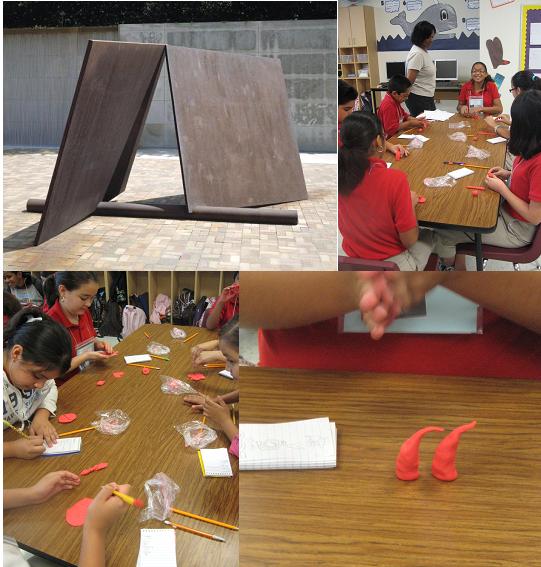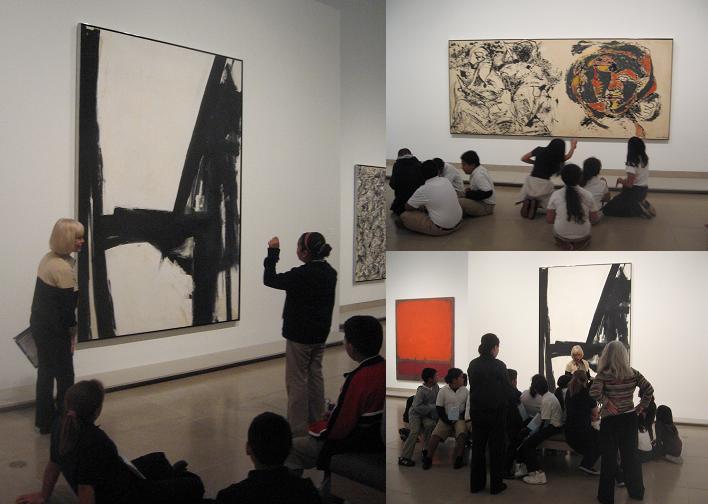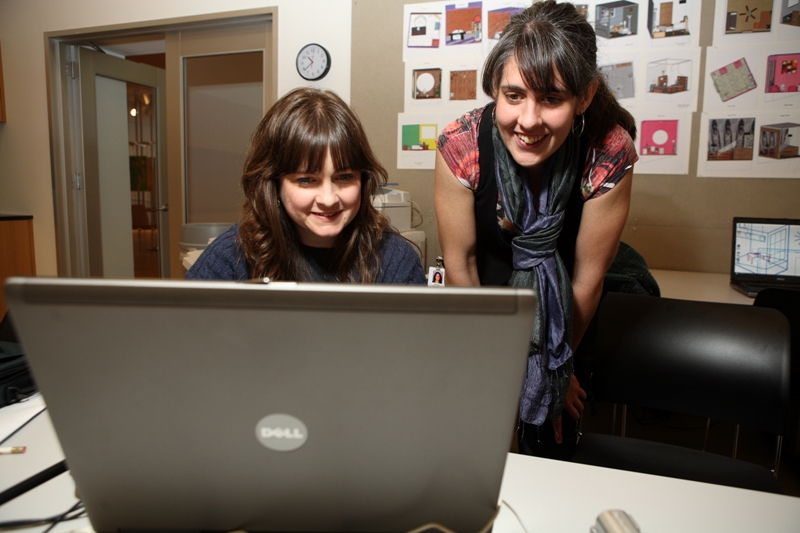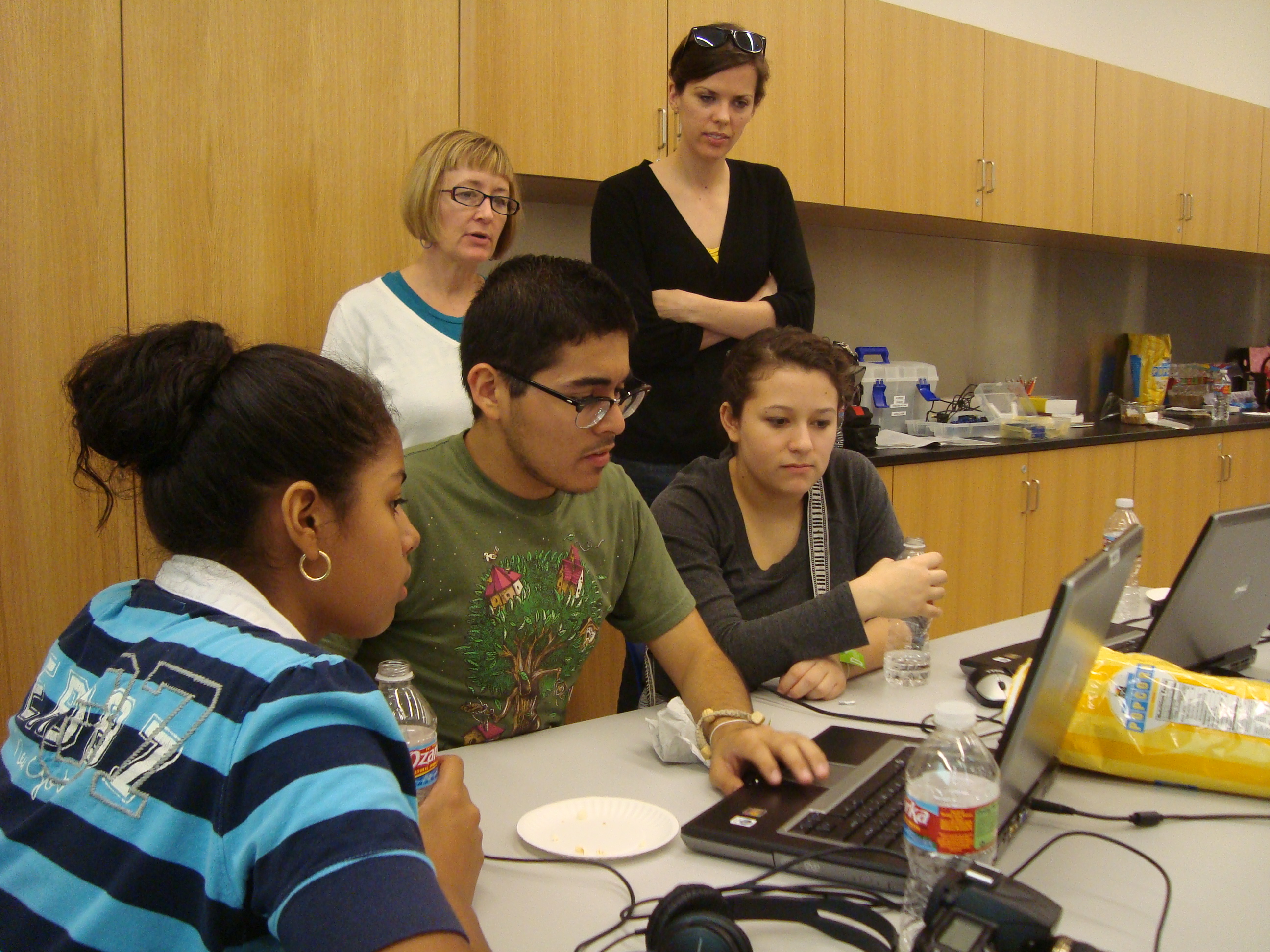Logan Acton
McDermott Intern for Teaching Programs
Official behind-the-scenes blog of the Dallas Museum of Art
Logan Acton
McDermott Intern for Teaching Programs
Dave Herman has partnered with the DMA’s Education divison in a variety of ways. As President and Creative Director of Preservation LINK, Inc., Dave initiated a partnership with the DMA that resulted in an annual exhibition of photographs by participants in Preservation LINK’s Point of View program. He was invited to serve on an advisory board for the development of a new type of Go van Gogh outreach program, based on his perspective as a professional photographer and his teaching experiences with students. Dave also led several workshops as the February Visiting Artist in the Center for Creative Connections as well as a Summer Art Camp during 2009. In summary, we enjoy partnering with Dave and take every opportunity to work with him.
You describe yourself as a visual sociologist. Can you tell us what that means to you?
Visual sociology is, in a lot of ways, documentary in nature. It is almost as if you put out a hypothesis or investigative question, and then you document what you find out and share some of those answers visually. It lends itself to a different kind of attention, because you’re trying to put pieces of puzzles together and understand what that all looks like. Visual sociology is also about how people interact with each other and how they respond to things.
Was there a defining experience or person in your life that led you to where you are today?
I first associate my mom and dad with helping to shape me and my values. A lot of what I do is based on my background and what I believe in. My work with students through Preservation LINK comes from a passion to help kids understand themselves, understand their potential, and to be confident that they can reach their goals. One thing that motivates me now, even as an artist, is that I didn’t necessarily have that growing up. This is something really important – for students to have guidance and the opportunity to grow, to have ownership, and to eventually have a sense of “I’ve got this now”.
Over the six years that I’ve known you, I’ve witnessed exciting growth with Preservation LINK. Do you have any advice for others who are interested in starting a non-profit organization with the goal of educating youth through literacy, art, and technology?
I would say the first thing as an initiator, dealing with kids, is to make sure you’re reaching for the sky. Make sure that you’re bringing the very best to young folks. I say that because sometimes when we talk about equipment, for instance, some people say “let’s just get this (lesser value) equipment because they’re kids and they don’t need a big camera”. In reality, that is what they need. For them to grab onto something real at a certain level, you’re able to push your message and your lesson a little bit further.
Also, believe in your vision. Know how or learn how to manage it.
How does research and evaluation factor into your program development and implementation?
In a big way. Evaluation and research impacts and informs how we move forward. It informs how we deliver programs and how we assess our accomplishments. We are able to see what the impacts of our programs are on the community, students, parents, and the adults that supports kids’ learning. We wouldn’t be the same organization that we are now if it wasn’t for the evaluation and research that is a part of Preservation LINK.
What do you most hope students who participate in your programs will walk away with from their experiences?
I want the students to know that people care about who they are, what they learn, and what they want to become. I hope they’re motivated to take even more ownership in their lives.
See photographs taken by elementary students during Presevation LINK’s Point of View Program at the Dallas Museum of Art. The exhibition, titled Through the Eyes of Our Children: Something Beautiful, will be on view from May 14-August 29 on the M2 level of the Museum, adjacent to the Mayer Library. View images from past Preservation LINK programs here.
Every child is an artist. The problem is how to remain an artist once we grow up.
The halls and galleries of the DMA fill up this spring with two installations of creative work by young artists in the community. Earlier this month, the Young Masters exhibition opened in the Dallas Museum of Art’s Concourse. The exhibition features a selection of artworks created by Advanced Placement Art students from Dallas area high schools who participate in the O’Donnell Foundation AP Studio Arts Incentive Program. The Incentive Program focuses on making Texas the strongest state in AP arts education and preparing students for life in the 21st century as critical thinkers with global perspectives. A total 280 works were submitted for the juried exhibition, which included two rounds of judging. The DMA’s own Jeffrey Grove, Senior Hoffman Family Curator of Contemporary Art, selected the final winners. Katy Wood from Booker T. Washington High School took away top honors with her self-portrait Looking Glass Self, a color digital photograph. In her statement Katy says. “Psychology greatly influences my artwork. In this piece, I explored a psychological theory called ‘looking-glass self’, in which one’s self can be reflected by the society and environment’s perceptions.” Images by additional award winners are featured on the AP Arts Web site.
In April, the work of young artists from fourteen elementary, middle, and high schools in the Dallas area will be on display in conjunction with the exhibition Coastlines. These artists are part of the Young Artist’s Program, an education-based initiative presented with the Museum’s annual fundraising event the Art Ball. Each year the Art Ball provides essential funding for the DMA’s exhibitions programs and gives students throughout Dallas an opportunity to make art in response to a unique theme derived from a DMA exhibition. Inspired by images of coastal landscapes and the sea, many of the schools participating in the Young Artist’s Program this year are creating large-scale collaborative works that will fill gallery spaces on the first floor. Works in all media will be on view to the public from April 15 to April 24, 2010, and the exhibition will be accompanied by a video documentation of students working.
Nicole Stutzman
Director of Teaching Programs and Partnerships
I began my relationship with the Dallas Museum of Art when I was an AP art student at Frisco High School and visited the Museum with my class. Although I spent at least three hours a day in art classes during my senior year, the Museum felt like it was a world apart from my own, much further than the half hour drive from my school. After graduating from Frisco High, I earned a scholarship to the University of Texas at Dallas where I was accepted into Collegium V, the honors program there. In addition to the courses available on campus, each spring UT Dallas and the Dallas Museum of Art collaborate to offer an innovative honors seminar that takes place at the Museum.
I signed up for the partnership class in the spring of my freshman year, a course devoted to the Maya, and I fell in love with the Museum. I took the class again the following year, studying modernism, then once more the next spring, studying the process of creativity. Although I had graduated with my Bachelor´s degree in Art & Performance by the time my fourth year arrived, I was able to participate as a graduate student auditing the course, this time about the senses in art and literature. As my scholarship program drew to a close, I learned that the Museum offers eight McDermott internships: four in the Curatorial Department and four in Education. I knew I loved art, I knew I loved sharing the things I was passionate about with others, so I applied to work at the Museum doing just that. Not long after, I found myself walking through the Museum’s doors as the McDermott Teaching Programs Intern.
Not only have I been afforded the great opportunity to participate in teacher workshops and docent training as well as leading tour groups of all ages, but I have found myself on the other side of the table in the spring honors seminar. My experiences as a high school, undergraduate, and graduate student have shaped the way I see the Museum and the educational opportunities it provides, especially the way we interact with visitors. As someone who has witnessed it firsthand, I know that transformative experiences with art in the Museum are possible. My goal as a museum educator is not to impart a specific set of facts to a group of students, but rather to spark each student’s sense of wonder and provide them a starting point for whatever journey their imagination takes.
If you were to wander through the African galleries today or tomorrow, you might encounter a studious group of 5th graders and their teachers from Harry C. Withers elementary. Clustered around works of art, the students will be sketching and talking about what they see, think, and feel in response to the art. When looking at the Stool supported by kneeling female figure from the Luba peoples of the Democratic Republic of the Congo, the discussion may range in topic from the geometry and patterns they see to ideas about beauty and the significant role of women in the Luba culture to the king who sat on this stool.
Math teacher Debbie Hurley will likely be leading this discussion. With a team of teachers, Debbie and the Withers 5th grade students have visited the DMA every year for the last 15 years! I’ve seen her teach with the Stool many times in the galleries and learned much from her passionate approach to teaching and her ability to help students make connections between the art and their lives. In 1995, Debbie was among a group of Dallas ISD teachers and DMA education staff who collaborated to create a teacher-led curriculum called “African Traditions” for the Museum’s Art of Looking school partnership program. The Art of Looking partnership program is 17 years old this year. A program for 4th – 6th grade students and teachers, the Art of Looking champions interdisciplinary approaches to works of art, guides students through deep looking experiences with art that help build creative and critical thinking skills, and fosters a connection between Dallas ISD schools and their hometown Museum.
The Art of Looking partnership program, more so the “African Traditions” experience, is so embedded in the Withers school culture that it defines what it means to be a 5th grader at Withers, and what it means to be a parent of a 5th grader (who come often as chaperones on Museum visits).
This week the Withers Wildcats make their 15th annual visit to the Museum and it will be an extra special one. Following their Friday session in the galleries looking at art, students will join African drummer Leo Hassan for a hands-on experience with African drums. I’ll be sure to post pictures late Friday – so come back for a look!
Nicole Stutzman
Director of Learning Partnerships with Schools and the Community
Today’s “Photo Post” gives you a behind the scenes look at a typical day for me. I spend a lot of time at my desk communicating with teachers (and docents) over the phone and email. But I also like to greet students as they come into the Museum–nothing beats hearing their “oohs” and “aahs” as they see the Barrel Vault for the first time! Happy Friday, everyone!
Shannon Karol
Tour Coordinator
Every once in a while, a teacher will take advantage of our Go van Gogh programs and schedule everything that is possible for his/her students. This is the case with the fourth grade teachers at Esperanza “Hope” Medrano Elementary, a Dallas ISD school.
Over a three month period, we visited Medrano Elementary fourth graders four times with four different Go van Gogh programs. As a result, Go van Gogh volunteers and staff established a unique relationship with a mixture of people at Medrano Elementary. Their front staff recognized us and welcomed us warmly when we arrived at the school. We looked forward to our visits, because the students are bright, engaged, and enthusiastic. The teachers are always prepared and helpful as well. Because of our familiarity with the school, we piloted a new program with one of the fourth grade classrooms, during which we received great feedback from both the teacher and the students.
Our final visit to the Medrano Elementary fourth graders was in mid-November. Last week, we were surprised and delighted by an envelope full of thank-you letters written and illustrated by the students. Below are a few highlights.
Melissa Nelson
Manager of Learning Partnerships with the Community
One of the DMA’s longest running partnerships is with Dallas ISD’s Talented and Gifted (TAG) program. For the past 21 years, 4th – 6th grade students explore works of art from all times and places through interactive experiences like dramatic interpretation, debate, writing, and sketching. Since 2000, each visit focuses on a BIG Idea question like “How is a work of art powerful?,” “How is place important?, ”How is perspective used in works of art?,” and “What do works of art tell us about the past, present, and future?” These open-ended questions support a variety of answers which may relate to students’ life experiences and prior knowledge.

Students from Botello Elementary create verb sculptures using words (i.e. symmetry) that Richard Serra may have used to create his sculptures. They looked Richard Serra's "Untitled" for inspiration.
This year, like the many years before, has been fantastic! There are 20 schools participating in this four-visit program with two Museum visits and two classroom visits. Each of these visits lasts for 2 hours and are led by docents and Museum staff. The TAG teachers commit to having the same 20-25 students participate in the program and it is exciting to see the student’s growth with each visit as they think critically and share creative answers to these BIG Idea questions.
The fall semester began in the classroom with “What does it mean to be an art investigator?,” which focused on looking closely and investigating visual clues in portraits and landscapes, creating verb-inspired sculptures using modeling material, and making connections between music and Claude-Joseph Vernet’s painting, Mountain Landscape with Approaching Storm.

Students from Reinhardt Elementary used their arms and hands to mimic similar gestures expressed in Jackson Pollock's "Portrait and a Dream" and Franz Kline's "Slate Cross."
During Visit 2, students considered the question “How are emotions and gestures expressed in works of art?” as they posed like figures in works of art featured in the All the World’s a Stage exhibition, explored the expressive and emotive qualities of line and color, and created a sequence of events based on contemporary photography by artists, Charlie White and Gregory Crewdson.
The BIG Ideas for the final two visits are “What are ways cultures can influence each other?” and “What are the connections between art, music, dance, and theater?” Be sure to look for an update about the TAG Museum program when I blog about the visits later in the spring!
Until next time…
Jenny Marvel
Manager of Learning Partnerships with Schools
 I invite you to make your way soon to the Tech Lab in the Center for Creative Connections at the Dallas Museum of Art for a new experience with art and technology. On most days laptops await you and your students in an open lab setting. You can research one of the many artworks and artists viewed in the Museum galleries.
I invite you to make your way soon to the Tech Lab in the Center for Creative Connections at the Dallas Museum of Art for a new experience with art and technology. On most days laptops await you and your students in an open lab setting. You can research one of the many artworks and artists viewed in the Museum galleries.
Workshops and special programs for all ages enliven the Tech Lab space on Thursday nights, Late Nights, and weekends. This past Saturday, the Booker T. Washington  High School video club met with local painter and filmmaker, Trayc Claybrook. The task at hand? Make a one- minute movie using the theme “chairs”. Inspired by the design and film work of Charles and Ray Eames, the students ventured into the galleries for filming and initiated the editing process in the Lab. Other workshop topics for families, kids, teens, and adults include stop-motion animation, podcasting, graphic design with Photoshop Elements, mini-documentary, and photography. Workshops include time in the galleries connecting with works of art and time in the Tech Lab working creatively with technology tools to produce original work. Check the Web site for workshop listings — a new calendar will be posted soon!
High School video club met with local painter and filmmaker, Trayc Claybrook. The task at hand? Make a one- minute movie using the theme “chairs”. Inspired by the design and film work of Charles and Ray Eames, the students ventured into the galleries for filming and initiated the editing process in the Lab. Other workshop topics for families, kids, teens, and adults include stop-motion animation, podcasting, graphic design with Photoshop Elements, mini-documentary, and photography. Workshops include time in the galleries connecting with works of art and time in the Tech Lab working creatively with technology tools to produce original work. Check the Web site for workshop listings — a new calendar will be posted soon!
Drop by the Lab on the second Thursday of every month and every Late Night for hands-on Open Lab sessions with Technology experts. Coming up at the November Late Night: University of North Texas art students present interactive art you can touch!
Nicole Stutzman
Director of Learning Partnerships with Schools and the Community